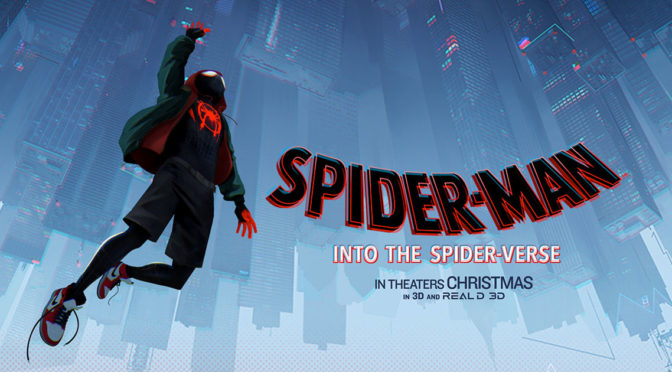Sony may have teamed up with Marvel for live-action Spider-Man after the failure of its The Amazing Spider-Man reboot series, but they have also made a new animated film on their own, with some assistance from Phil Lord and Chris Miller (The Lego Movie). Spider-Man: Into the Spider-Verse tells the story of how Miles Morales (Shameik Moore; Dope), a teenager and Spider-Man fan, gets superpowers and takes over for Peter Parker as Spider-Man and how he faces his first major dilemma. Kingpin has created a particle accelerator to contact alternate universes that leads to other Spider-People entering Miles’ world. He has to get them back to their original homes and shut down Kingpin’s machine before it destabilizes and destroys all of New York.
The film’s art design is perfect for the material. Sony Pictures Animation has used a 3D look that, at a glance, appears almost 2D. It strikes a perfect balance between the flat look of comic book images and the additional depth that modern audiences are used to in animated features. The colors are bright and special attention is paid to shadows that add life to the characters. The style also augments Spider-Man’s signature method of transport: his web swinging. The smooth animation captures the fast and kinetic arcs of each swing much better than any of the live action adaptations. The slightly cartoonish art also allows the film to lean into its comic book origins. Characters can use or even expand upon their often exaggerated designs, like Kingpin’s massive size, without feeling out of place as they would if the film wasn’t animated.

As expected from the influence of Lord and Miller, the writing employs the quick-witted humor of their previous works. The film is self-aware and often winks at the audience or references other properties including other Spider-Man media. Unlike in The Lego Movie, the script here builds on these references rather than just calling them out. In particular, co-writers Lord and co-director Rodney Rothman use the multiverse conceit to play with audience expectations. They are fully aware that the Spider-Man story has penetrated general pop culture knowledge and, instead of rehashing origins for Peter Parker, they pull from obscure and hilariously strange comic runs or subvert existing knowledge of the main villains for some great character reveals. These choices along with the focus on the lesser-known Miles Morales as the hero make the film’s story fresh and mostly free from Spider-Man fatigue.
The downside to the writing style is that the overall narrative lacks substance. Each character is well written with depth behind their actions, but the larger “save the world” plot is forgettable and interchangeable with dozens of other superhero films. There is a subplot involving Miles’ family and his father’s role as a police officer, but the emotional stakes to the potential doomsday are missing. The climactic action scenes are colorful, fun fights but lack the peril needed to produce any level of tension. The action and comedic dialogue zip by in agreeable fashion, but without palpable consequences Spider-Man: Into the Spider-Verse is only light entertainment.

3/5 stars.
